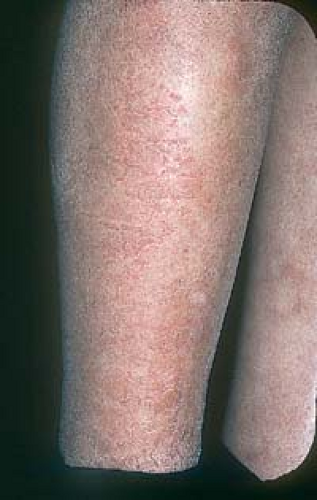Xerosis: The “Dry” Patient
 Xerosis
Xerosis
 Asteatotic eczema
Asteatotic eczema
 Atopic dermatitis
Atopic dermatitis
Overview
Xerosis, or dry skin, is a common occurrence in winter climates, particularly in conditions of cold air, low relative humidity, and indoor heating. Xerosis can affect anyone, but it tends to be more severe in certain persons, especially those with a hereditary predisposition.
Modern lifestyles are also contributing factors. In Western societies, people tend to overbathe, and they often live and work in overheated spaces.
The word “dry” is sometimes misapplied. Skin that appears to be dry (i.e., that shows a buildup of scale) may not always be suffering from a lack of water but rather from an overadherence or hyperproliferation of scale. Overadherence of scale may occur in patients with ichthyosis (see Chapter 2, “Eczema”). Hyperproliferation of scale is noted in atopic dermatitis, psoriasis, seborrheic dermatitis, and common dandruff.
Xerosis
Xerosis, or dry skin, tends to be most apparent on the hands and lower legs.
It becomes especially common in persons who are older than 65 years of age (Fig. 16.1).
 16.1 Xerosis. Dry skin tends to be most apparent on the hands and lower legs. This elderly patient’s legs are dry and scaly. |
Pathogenesis
The reasons why the skin becomes—or appears to become—dry are not well understood. It has been proposed that xerosis may be secondary to diminished production of sebum (asteatosis), as well as to reduced eccrine gland activity. However, other biochemical factors related to aging skin have also been implicated.
Popular folklore and the lay literature often blame xerosis on inadequate water ingestion, but there is no scientific basis for this claim.
Asteatotic Eczema
See also Figure 2.52.
Asteatotic eczema (winter eczema) is caused by a relative loss of water from the skin through evaporation, a lack of normal desquamation, and, possibly, a decline in the production of sebum (the skin’s natural lubricant and sealant).
Most often seen on the shins, with seasonal recurrences during the winter months, this form of eczema is a common, sometimes pruritic, low-grade dermatitis. Early on, the affected skin feels and looks dry (Fig. 16.2); later, an inflammatory dermatitis may evolve.

16.2 Asteatotic eczema. Xerosis and subtle changes consisting of exaggerated skin markings are seen in this patient.
Stay updated, free articles. Join our Telegram channel

Full access? Get Clinical Tree

 Get Clinical Tree app for offline access
Get Clinical Tree app for offline access



